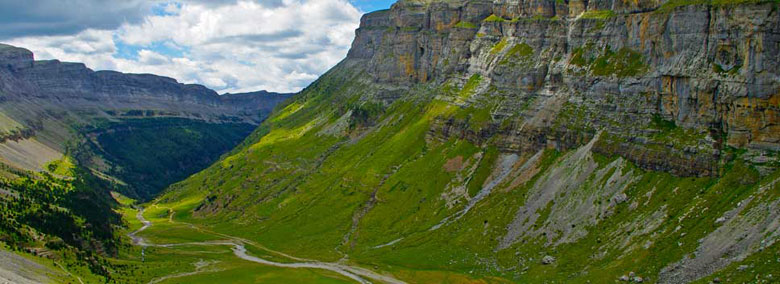
The Ordesa Valley in the Spanish Pyrenees was carved by a glacier. (Photograph courtesy of Taylor Perron.)
Course Meeting Times
Lectures and Labs: 3 sessions per week, 2 hour per session
Description
Continents collide, oceans form and disappear, new land is constantly created and old land constantly destroyed. The Earth freezes over, volcanoes give lava to the land and gases to the atmosphere. The ice melts, glaciers turn into rivers, which cut through mountains as those mountains fall apart in landslides and debris flows. Life begins and everything changes. These are physical, chemical and biological problems, but understanding them requires us to constantly think in four dimensions, on time and length scales from atoms and nanoseconds to thousands of miles and billions of years. We will apply the fundamental sciences to the Earth system, and learn to read the history of the Earth in its rocks and their mineral constituents.
Geology is the core discipline of the earth sciences and encompasses many different phenomena, including plate tectonics and mountain building, volcanoes and earthquakes, and the long-term evolution of Earth’s atmosphere, surface and life. Because of the ever-increasing demand for resources, the growing exposure to natural hazards, and the changing climate, geology is of considerable societal relevance. This course introduces students to the basics of geology. Through a combination of lectures, labs, and field observations, we will address topics ranging from mineral and rock identification to the origin of the continents, from geologic mapping to plate tectonics, and from erosion by rivers and glaciers to the history of life.
Prerequisites
The course is designed to be accessible to students from all disciplines. No geology background is assumed.
Course Structure
The course consists of lectures, laboratory exercises, and one weekend field trip, all of which are mandatory. The material presented in lectures roughly parallels the topics of the field trip and lab exercises. Some labs will be used to prepare for the field trip and subsequently analyze field observations and measurements. There are four quizzes in the course.
Assessment
Grading
| ACTIVITIES | PERCENTAGES |
|---|---|
| Field Trip Report, Lab Reports, and Exercises | 60 |
| Quizzes (4) | 35 |
| Class Participation | 5 |
The first quiz and the field trip exercise together count for one quiz. Reports will be evaluated on clarity of presentation as well as soundness of analysis. The “rock of the week” exercises distributed every Friday throughout the semester will be equivalent to one lab.
Collaboration
Students are encouraged to collaborate on laboratory exercises, but each student must perform all the required calculations and write his / her own reports. Students who submit work that is not their own will receive no credit for the assignment.
Late Assignments and Missed Field Trips
Late assignments will be penalized one fractional letter grade (a +/- unit) per day late. Missed field trips must be excused in advance, and students must instead prepare a major written report and oral presentation on a related topic that will be assigned.
Course Materials
Textbook
Grotzinger, John and Thomas H. Jordan. Understanding Earth. W. H. Freeman and Company, 2006. ISBN: 9780716766827.
Quizzes may include material from assigned readings, even if it is not covered in lecture.
Labs
Colored pencils, ruler, and calculator. Hand lenses for mineral identification will be made available to students for the labs.
Field Trip
All students will need sufficient clothing and footwear to stay warm and (mostly) dry in changeable weather conditions.










